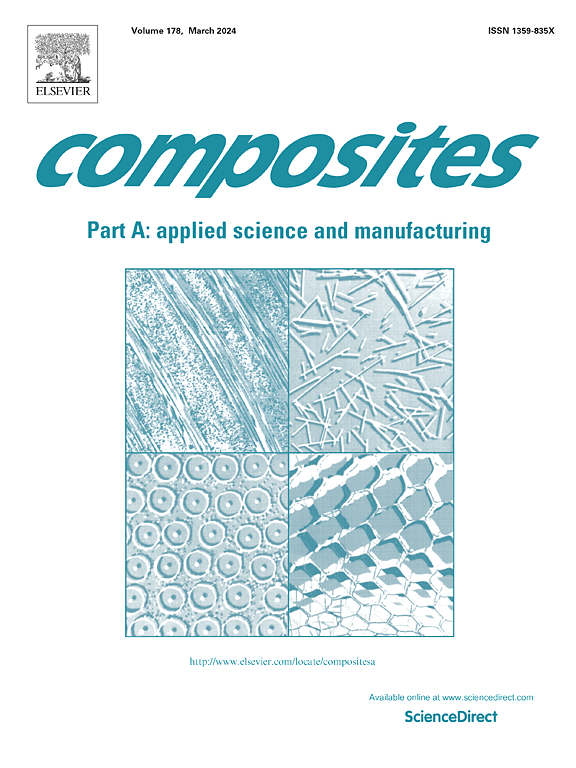Three-Dimensional damping behavior prediction method for sandwich Composites: A novel approach Validated by experimental modal analysis
IF 8.1
2区 材料科学
Q1 ENGINEERING, MANUFACTURING
Composites Part A: Applied Science and Manufacturing
Pub Date : 2025-04-28
DOI:10.1016/j.compositesa.2025.108988
引用次数: 0
Abstract
A novel three-dimensional method was proposed to predict the damping behavior of carbon fiber reinforced plastic/polymethacrylimide/carbon fiber reinforced plastic (CPC) sandwich composites. Based on Mindlin shear deformation theory and Hamilton’s principle, it calculates the 3D frequency response function, particularly in the longitudinal and thickness directions, along with natural frequency, loss factor, and mode shape. Modal analysis validates the model, with maximum errors of 8.51% in natural frequency and 5.14% in thickness-direction loss factor, showing high predictive accuracy. Results also indicate that reducing core density enhances damping, causing faster energy dissipation in the thickness direction than in the longitudinal direction. This suggests that optimizing core density can improve damping performance without compromising stiffness. The proposed method serves as a practical tool for analyzing three-dimensional vibration characteristics of high-damping sandwich composites, offering useful guidance for structural design and promoting its application in aerospace and other engineering systems.
夹层复合材料三维阻尼特性预测方法:一种经模态试验验证的新方法
提出了一种新的三维预测碳纤维增强塑料/聚甲基丙烯酰亚胺/碳纤维增强塑料(CPC)夹层复合材料阻尼行为的方法。基于Mindlin剪切变形理论和Hamilton原理,计算三维频响函数,特别是纵向和厚度方向的频响函数,以及固有频率、损耗因子和模态振型。模态分析验证了该模型的有效性,固有频率和厚度方向损失因子的最大误差分别为8.51%和5.14%,具有较高的预测精度。减小岩心密度会增强阻尼,导致厚度方向的能量耗散速度快于纵向方向。这表明优化岩心密度可以在不影响刚度的情况下改善阻尼性能。该方法可作为分析高阻尼夹层复合材料三维振动特性的实用工具,为结构设计提供有益的指导,并促进其在航空航天和其他工程系统中的应用。
本文章由计算机程序翻译,如有差异,请以英文原文为准。
求助全文
约1分钟内获得全文
求助全文
来源期刊

Composites Part A: Applied Science and Manufacturing
工程技术-材料科学:复合
CiteScore
15.20
自引率
5.70%
发文量
492
审稿时长
30 days
期刊介绍:
Composites Part A: Applied Science and Manufacturing is a comprehensive journal that publishes original research papers, review articles, case studies, short communications, and letters covering various aspects of composite materials science and technology. This includes fibrous and particulate reinforcements in polymeric, metallic, and ceramic matrices, as well as 'natural' composites like wood and biological materials. The journal addresses topics such as properties, design, and manufacture of reinforcing fibers and particles, novel architectures and concepts, multifunctional composites, advancements in fabrication and processing, manufacturing science, process modeling, experimental mechanics, microstructural characterization, interfaces, prediction and measurement of mechanical, physical, and chemical behavior, and performance in service. Additionally, articles on economic and commercial aspects, design, and case studies are welcomed. All submissions undergo rigorous peer review to ensure they contribute significantly and innovatively, maintaining high standards for content and presentation. The editorial team aims to expedite the review process for prompt publication.
 求助内容:
求助内容: 应助结果提醒方式:
应助结果提醒方式:


